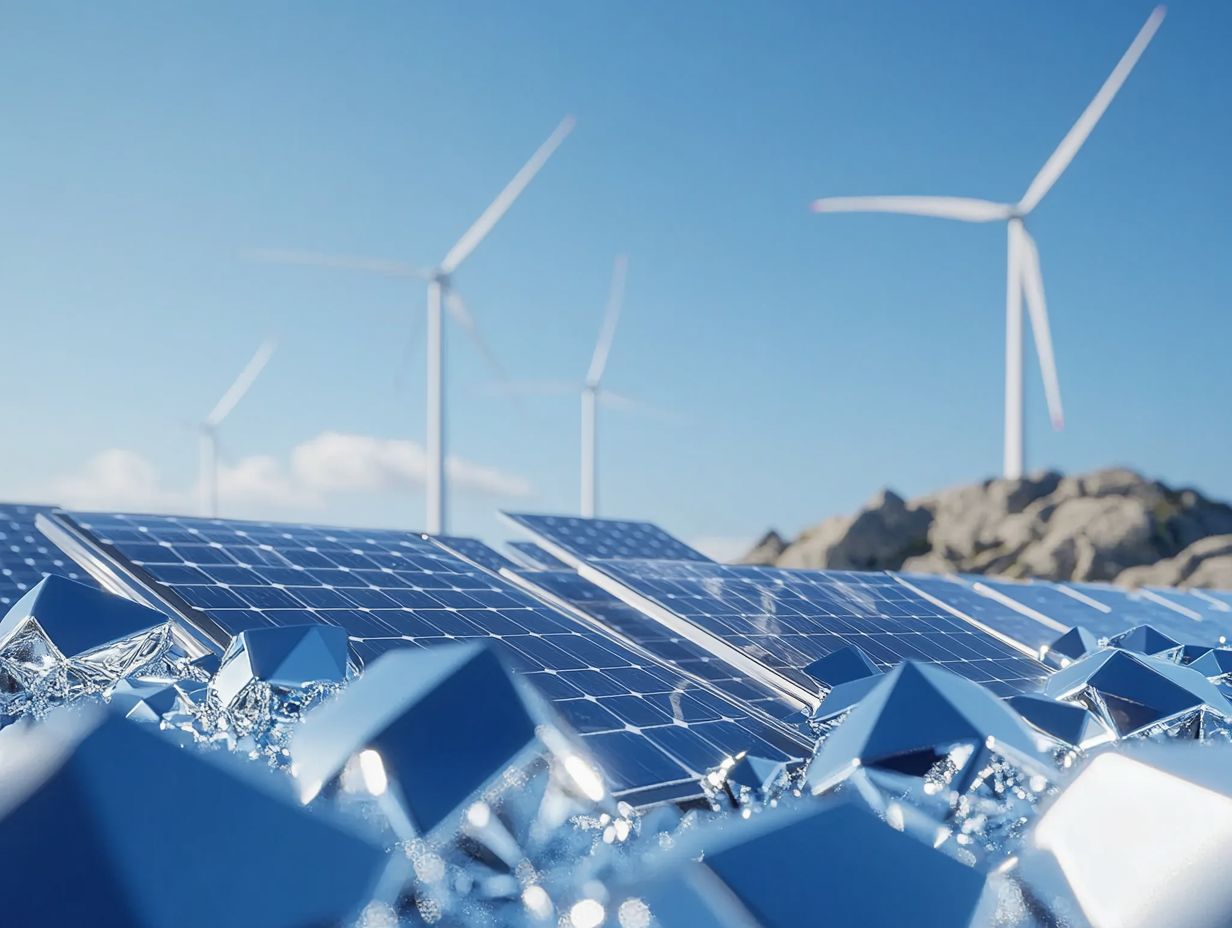The Future of Palladium in Renewable Energy
Palladium, a precious metal renowned for its role in catalytic converters, is stepping into the spotlight as a crucial element in the renewable energy arena.
This article delves into its existing and prospective applications in energy, shedding light on the advantages and challenges of integrating palladium into sustainable technologies. It scrutinizes efficiency and cost-effectiveness, tackles supply and environmental concerns, and highlights the latest research and innovations.
Explore how palladium could play a pivotal role in shaping the future of renewable energy and propel us toward a more sustainable tomorrow.
Contents
- Key Takeaways:
- Palladium’s Role in Renewable Energy
- Benefits of Using Palladium in Renewable Energy
- Challenges and Limitations of Palladium in Renewable Energy
- Research and Development in Palladium for Renewable Energy
- Frequently Asked Questions
- What does palladium do for renewable energy today?
- Will palladium continue to be a crucial element in the future of renewable energy?
- How does palladium contribute to reducing emissions in renewable energy?
- Is palladium a finite resource for renewable energy?
- What other roles does palladium play in renewable energy?
- What challenges might palladium face in renewable energy?
Key Takeaways:

- Palladium is a rare metal vital for renewable energy technologies.
- Using palladium boosts efficiency and cuts costs in renewable energy processes.
- Research and development in palladium for renewable energy is ongoing, with potential for further advancements in the future.
What is Palladium?
Palladium is a precious metal that has gained attention due to its vital role in various industrial applications, especially in the automotive sector. This versatile metal, along with its counterpart platinum, is primarily used in catalytic converters to reduce harmful emissions from internal combustion engines.
Its significance stretches beyond automotive uses; palladium is increasingly recognized as a crucial element in the shift toward clean energy solutions, including hydrogen fuel technologies, highlighting its importance in the global supply chain and investment landscapes.
As nations strive to meet stringent environmental standards, the demand for palladium in catalytic converters is rising. Major players like Johnson Matthey are pioneering innovative technologies that enhance emission reductions.
Historically, this metal has been pivotal in numerous advancements, with its applications evolving dramatically since its discovery in the early 19th century. According to the World Platinum Investment Council, palladium’s limited supply boosts its value as an asset for sustainability-focused portfolios.
With automotive demand skyrocketing and a transition to greener alternatives underway, this precious metal undoubtedly stands as a key player in both existing and emerging markets.
Palladium’s Role in Renewable Energy
Palladium plays an important role in renewable energy, especially as global efforts intensify toward cleaner energy solutions and reducing our carbon footprint.
This precious metal is making significant strides in the hydrogen economy, acting as a catalyst in hydrogen fuel cells. By doing so, it helps lower emissions and enables compliance with strict standards set by regulatory bodies in regions like the EU and China.
Current Uses in Renewable Energy
Currently, palladium is mainly used in hydrogen fuel cells, where it efficiently converts hydrogen energy into electricity. It also plays a vital role in catalytic converters for gasoline engines, ensuring compliance with increasingly stringent emissions standards.
This dual function highlights how palladium is a game-changer in the move to cleaner energy! In hydrogen fuel cells, it significantly enhances efficiency, paving the way for broader adoption across various sectors, including automotive and public transport.
As emissions standards tighten in regions like North America and India, the demand for palladium in catalytic converters surges. Automakers are honing in on advanced emission control technologies to meet regulatory demands, which in turn propels the market for palladium and solidifies its strategic importance in the automotive industry.
As emissions standards continue to tighten, now is the time for industries to invest in palladium technologies!
Potential Future Applications
As the world moves towards a more sustainable future, the potential applications of palladium are rapidly expanding, especially in the hydrogen economy and electric vehicles. Its unique properties are set to play a pivotal role in energy efficiency and emissions reduction.
This noble metal is not just vital for catalytic converters, which reduce harmful emissions from vehicles; it s now being investigated for use in fuel cells and hydrogen production systems. These innovations could transform how energy is stored and utilized. As industries accelerate their efforts to embrace electric vehicles, the demand for palladium is anticipated to surge. This demand is driven by its ability to facilitate cleaner emissions and improve battery performance.
Investment trends reflect this shift, with many considering palladium a strategic asset in their portfolios. These dynamics have the potential to reshape market structures and resource allocation significantly, prompting industries to rethink their sourcing strategies and investment priorities.
Benefits of Using Palladium in Renewable Energy

The benefits of using palladium in renewable energy are numerous, primarily highlighted by its remarkable efficiency and cost-effectiveness. This unique combination positions palladium as a crucial component in the global shift toward clean energy solutions, especially in hydrogen fuel applications.
Efficiency and Cost-Effectiveness
Palladium stands out for its remarkable efficiency in catalyzing chemical reactions, which directly impacts its cost-effectiveness across various applications, from catalytic converters to hydrogen fuel cells. This quality makes it an invaluable asset in the renewable energy sector.
In the automotive industry, the benefits of palladium are particularly apparent. Its catalysts play a crucial role in significantly lowering harmful emissions, allowing manufacturers to comply with stringent regulatory standards without facing exorbitant costs. In fact, case studies reveal that car manufacturers implementing palladium in their systems have slashed their emissions compliance expenses by up to 30%.
In the growing hydrogen fuel market, palladium-based catalysts have proven to enhance reaction rates. This innovation drives down production costs and enables quicker project payback periods, boosting investor confidence and elevating demand for clean energy technologies.
Challenges and Limitations of Palladium in Renewable Energy
While the benefits of palladium in renewable energy are substantial, you should also think about the challenges and limitations that accompany its use.
Notably, the ongoing supply deficit and the environmental issues tied to its mining and production can considerably influence market dynamics and sustainability initiatives.
Supply and Demand Issues
The urgent supply deficit of palladium, fueled by surging automotive demand and shifts in economic activity, presents a significant challenge for stakeholders in the renewable energy sector.
In recent years, the automotive industry has increasingly leaned on palladium for catalytic converters. Data shows that global palladium production struggles to keep up with this escalating demand; annual production hovers around 210,000 ounces, while consumption levels have skyrocketed to nearly 300,000 ounces. This widening gap between supply and demand has driven prices through the roof, positioning palladium as one of the most precious metals on the market today.
As an investor, it s crucial to keep a keen eye on these trends, because the tight supply situation continues to elevate prices and spark burgeoning interest in palladium-based investments.
For those interested in renewable energy initiatives, learning more about palladium can be a valuable step towards informed investment.
Palladium’s Role in Shaping Renewable Energy Solutions
Environmental Concerns
Environmental concerns surrounding palladium mining and production processes present real challenges, compelling you to allocate resources thoughtfully and seek innovative solutions. Make sure palladium fits your sustainability goals.
These challenges often arise from habitat destruction, water contamination, and greenhouse gas emissions, which can profoundly affect local ecosystems and communities. Industries are adopting palladium for emissions control and other technologies. This makes responsible sourcing increasingly important.
By implementing more sustainable mining practices, such as minimizing ecological footprints and enhancing waste management, you can lay the groundwork for a greener future. Strengthening recycling efforts to reclaim palladium from used products not only helps mitigate environmental damage but also conserves precious resources, reducing the dependence on newly mined materials.
Research and Development in Palladium for Renewable Energy

Research and development in palladium for renewable energy is vital as you navigate the landscape of innovative applications and technologies. By harnessing its unique properties, you can play a crucial role in advancing hydrogen fuel solutions and other clean energy initiatives, driving progress towards a sustainable future.
Current Studies and Innovations
Current studies and innovations in palladium are honing in on maximizing its efficiency in hydrogen fuel cells while exploring new catalysts that could further elevate clean energy applications. This positions palladium as a crucial player in the hydrogen economy.
Recent advancements in tiny technology have allowed researchers to craft palladium-based alloy catalysts that outshine traditional materials in both performance and durability. These innovations not only aim to slash the overall cost of hydrogen production but also boost the operational efficiency of fuel cells, signaling significant strides towards sustainable energy solutions.
The integration of palladium into various energy systems holds promise for expanding the horizons of clean energy applications. This could lead to reduced greenhouse gas emissions and a diminished reliance on fossil fuels, thus propelling the movement towards a greener future, as detailed in understanding palladium’s role in the future of tech.
The Role of Palladium in the Future of Renewable Energy
The role of palladium in the future of renewable energy is set to expand significantly, driven by increasing investment demand and its vital applications in the hydrogen economy, which is poised to become a major player in global clean energy initiatives.
As nations increasingly prioritize sustainability, this precious metal emerges as a standout for its effectiveness in refining and producing hydrogen fuel. The growing adoption of fuel cell technologies in transportation and industrial sectors indicates that understanding the role of palladium in green tech will be crucial in satisfying the demands of the hydrogen economy.
Think about how market dynamics will shift, as the scarcity of palladium will influence pricing, solidifying its value as a strategic investment. Don t miss out on the potential of this precious metal! By diversifying your portfolio with this resource, you could reap considerable long-term benefits, especially as manufacturers and energy companies ramp up their green technologies to harness hydrogen’s capabilities.
Frequently Asked Questions
What does palladium do for renewable energy today?
Currently, palladium is primarily used as a catalyst, a substance that speeds up a chemical reaction without being consumed, in hydrogen fuel cells, which are a key component in renewable energy technologies.
Will palladium continue to be a crucial element in the future of renewable energy?

Yes, experts predict that palladium’s role in renewable energy will only increase as the demand for clean energy sources grows.
How does palladium contribute to reducing emissions in renewable energy?
Palladium helps reduce emissions by converting hydrogen and oxygen into water vapor. This process creates a clean and efficient energy source.
Is palladium a finite resource for renewable energy?
Yes, palladium is rare and finite. It’s crucial to find sustainable methods for its use in renewable energy technologies.
What other roles does palladium play in renewable energy?
Palladium is key in making solar panels and biofuels from biomass. Its versatility in renewable energy is essential.
What challenges might palladium face in renewable energy?
Limited availability is a significant challenge for palladium. Price fluctuations could also impact its use due to its rarity.















